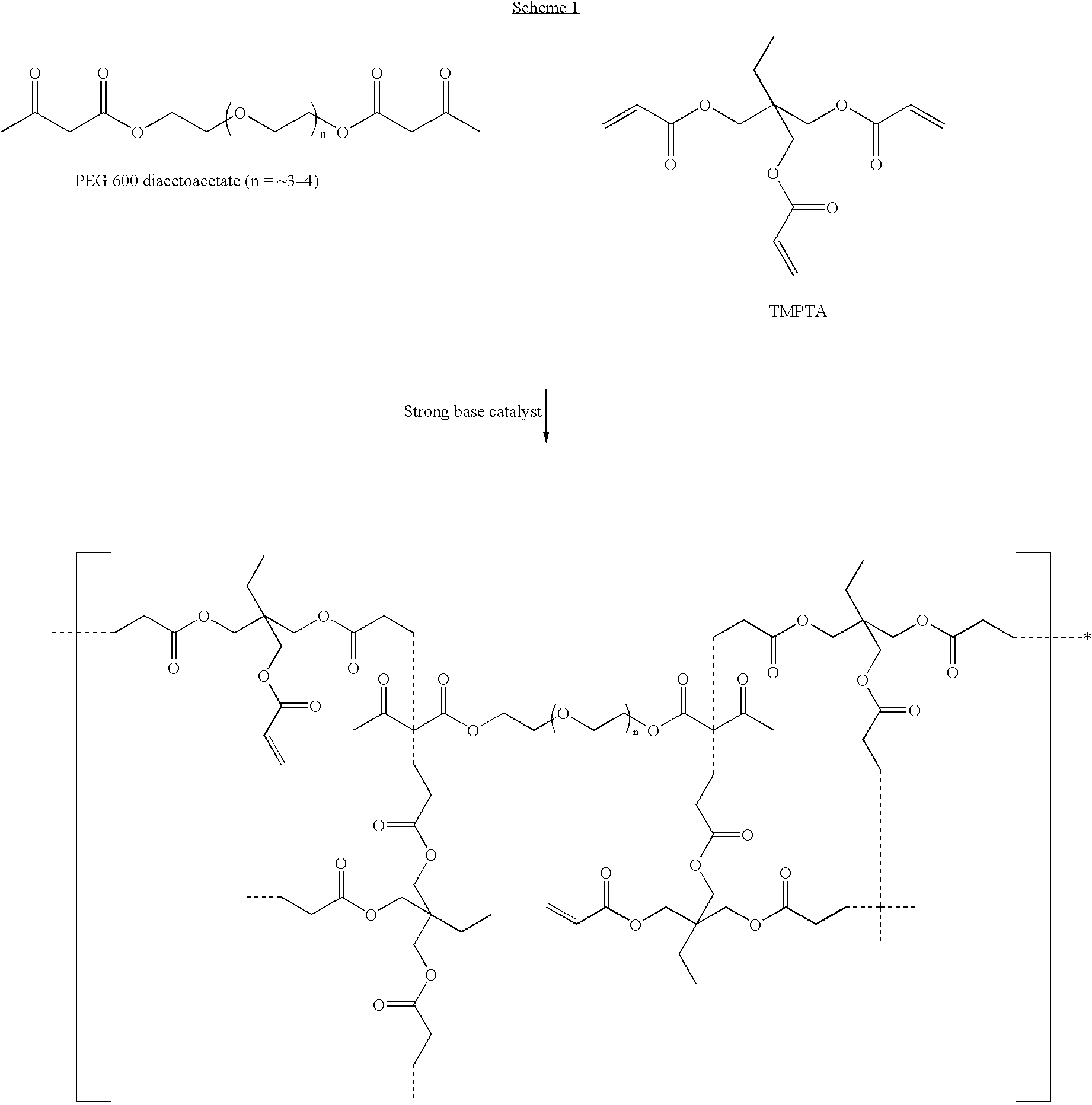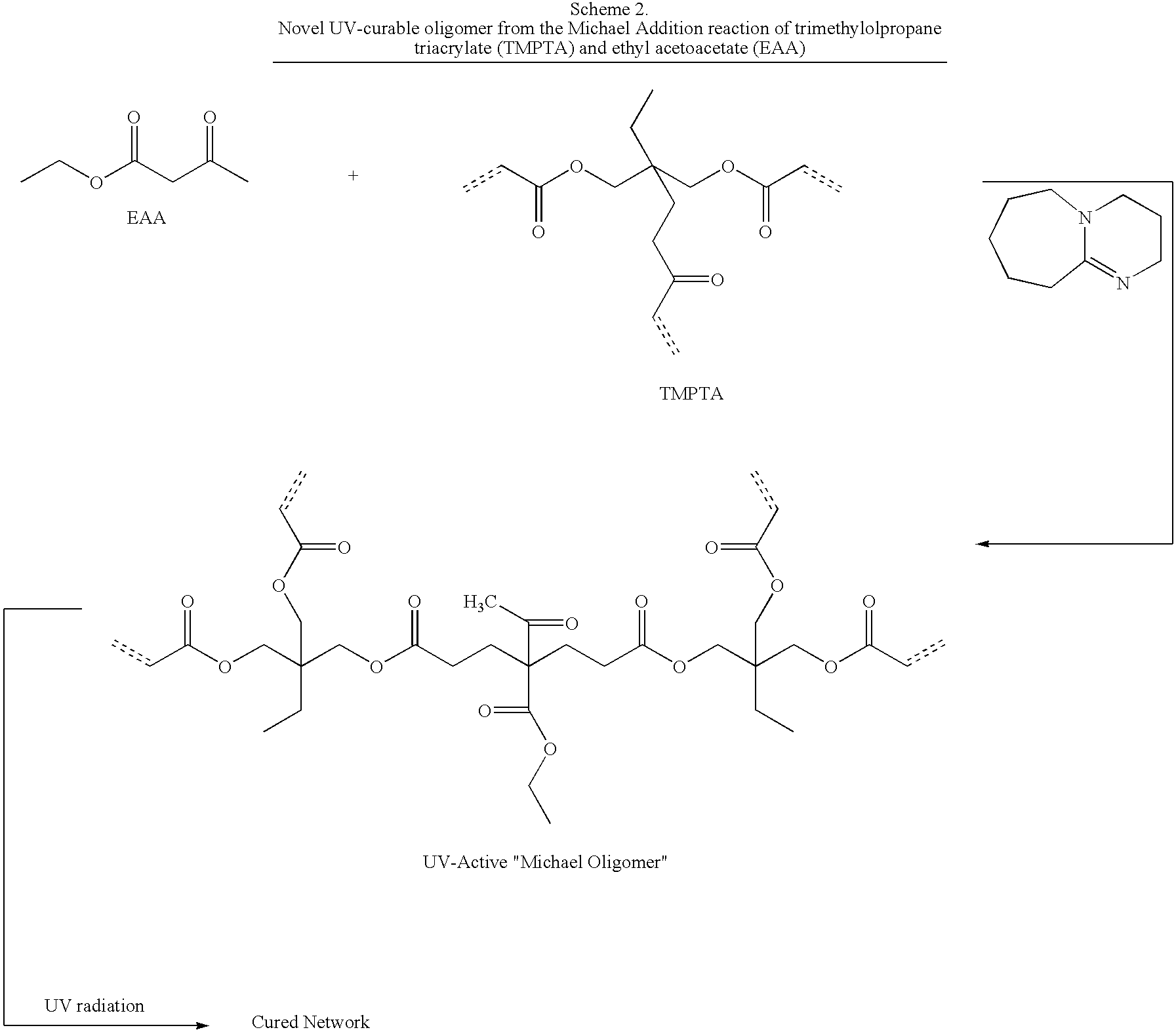Dual cure reaction products of self-photoinitiating multifunctional acrylates with thiols and synethetic methods
a multifunctional, self-photoinitiating technology, applied in the field of self-photoinitiating resins, can solve the problems of low functionality, adverse health effects, and inability to make networks liquid either with heat or solvent, and achieve enhanced adhesion, cure speed, and cure surface cure
- Summary
- Abstract
- Description
- Claims
- Application Information
AI Technical Summary
Benefits of technology
Problems solved by technology
Method used
Image
Examples
example 1
Novel Michael addition polyacrylate resins based on Michael donors ethyl acetoacetate (FAA), 2,4-pentanedione (2,4-PD) and allyl acetoacetate (ALAA), were synthesized according to the method described in U.S. Pat. No. 5,945,489 and U.S. Pat. No. 6,025,410. The Michael polyacrylate resins were mixed with various mercaptans at different levels. The resin / thiol mixtures were then applied to aluminum and stainless steel substrates and cured “tack-free” at the specified dosage. As is known in the art, tack-free cure is a qualitative assessment of film surface cure that requires no stickiness or “greasiness” to the touch of an ungloved finger or palm and no tack with the finger of a latex glove. Results are collectively reported in Table I:
TABLE IMarPolyViscositySolventResistanceMichael AdditionFunctionalWt. %(centipoiseDoseCross HatchResistancePencil(% 60° Gloss#PolyacrylateThiolThiol@ 25° C.(mJ / cm2)Adhesion(MEK rubs)HardnessRetained)*10.85 HDDA / 0.15——257115002B>200b57.4TMPTA / EAA 2.22...
example 2
Table II
Novel Michael addition polyacrylate resins based on HDDA and TMPTA in the ratio 85:15 and ethyl acetoacetate was synthesized according to the method described in U.S. Pat. No. 5,945,489 and U.S. Pat. No. 6,025,410. This resin was mixed with 10% of either trimethylol propane (tris-mercaptoprpionate) (TMPTMP) or γ-mercaptopropyl trimethoxy silane (MPTMS). The mixtures were then applied to an aluminum substrate and cured at different dosages to get a measure of the surface cure. Both tack-free (TF) and tack-free / smudge (TFS) cure responses were recorded. A coating given a TF grade is tack-free and multiple rubs with a cotton swab produce no marring. A coating given a TFS grade cures to a tack-free state, but is marred by multiple rubs with a dry cotton swab. The cure speed relates to the dosage of UV light required to achieve a tack-free coating and is stated below as defined by an International Light 393A “Light Bug” radiometer:
TABLE II10 fpm =20 fpm =30 fpm =40 fpm =50 fp...
example 3
Table III
Novel Michael addition polyacrylate resins based on various acrylates and Michael donors were synthesized according to the method described in U.S. Pat. No. 5,945,489 and U.S. Pat. No. 6,025,410. Selected resins were mixed with various mercaptans as indicated. The resin products were then characterized by photocalorimetry (Photo DSC). Photocalorimetry provides a measure of heat evolution after a precise dose of UV radiation from a medium pressure mercury lamp. While it is essentially a bulk property measurement, it can be used to compare resins against one another from a relative heat-release perspective. In general, greater heat release with a standard UV exposure or “pulse” extrapolates to faster and more complete cure of a given resin system. By way of example, in Table III, heat evolved for each UV pulse is recorded. When a large heat release is followed by a much smaller one, more double bonds were reacted with the first pulse. Polyacrylate monomer and oligomer “stan...
PUM
| Property | Measurement | Unit |
|---|---|---|
| Time | aaaaa | aaaaa |
| Percent by mole | aaaaa | aaaaa |
| Fraction | aaaaa | aaaaa |
Abstract
Description
Claims
Application Information
 Login to View More
Login to View More - R&D
- Intellectual Property
- Life Sciences
- Materials
- Tech Scout
- Unparalleled Data Quality
- Higher Quality Content
- 60% Fewer Hallucinations
Browse by: Latest US Patents, China's latest patents, Technical Efficacy Thesaurus, Application Domain, Technology Topic, Popular Technical Reports.
© 2025 PatSnap. All rights reserved.Legal|Privacy policy|Modern Slavery Act Transparency Statement|Sitemap|About US| Contact US: help@patsnap.com


